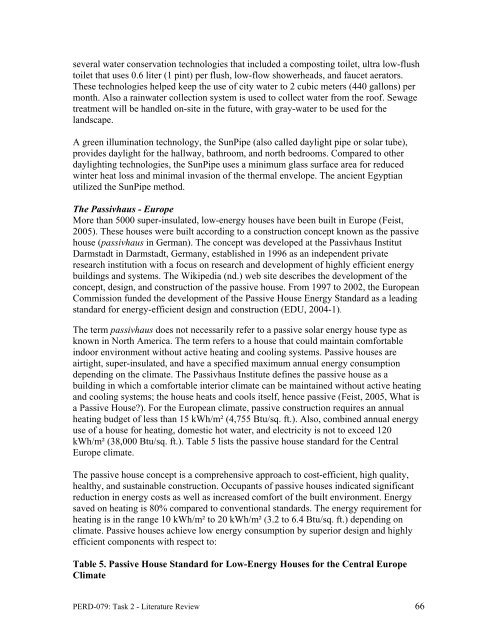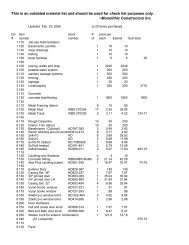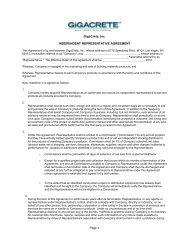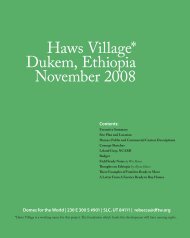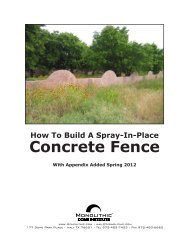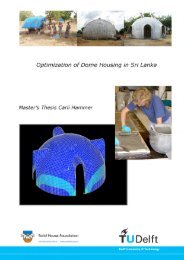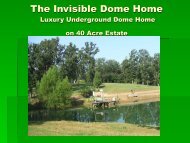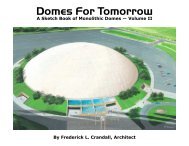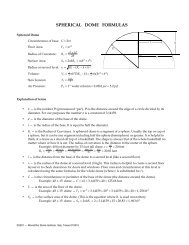Literature Review on Building Envelope, Heating and ... - Beeshive.org
Literature Review on Building Envelope, Heating and ... - Beeshive.org
Literature Review on Building Envelope, Heating and ... - Beeshive.org
You also want an ePaper? Increase the reach of your titles
YUMPU automatically turns print PDFs into web optimized ePapers that Google loves.
several water c<strong>on</strong>servati<strong>on</strong> technologies that included a composting toilet, ultra low-flush<br />
toilet that uses 0.6 liter (1 pint) per flush, low-flow showerheads, <strong>and</strong> faucet aerators.<br />
These technologies helped keep the use of city water to 2 cubic meters (440 gall<strong>on</strong>s) per<br />
m<strong>on</strong>th. Also a rainwater collecti<strong>on</strong> system is used to collect water from the roof. Sewage<br />
treatment will be h<strong>and</strong>led <strong>on</strong>-site in the future, with gray-water to be used for the<br />
l<strong>and</strong>scape.<br />
A green illuminati<strong>on</strong> technology, the SunPipe (also called daylight pipe or solar tube),<br />
provides daylight for the hallway, bathroom, <strong>and</strong> north bedrooms. Compared to other<br />
daylighting technologies, the SunPipe uses a minimum glass surface area for reduced<br />
winter heat loss <strong>and</strong> minimal invasi<strong>on</strong> of the thermal envelope. The ancient Egyptian<br />
utilized the SunPipe method.<br />
The Passivhaus - Europe<br />
More than 5000 super-insulated, low-energy houses have been built in Europe (Feist,<br />
2005). These houses were built according to a c<strong>on</strong>structi<strong>on</strong> c<strong>on</strong>cept known as the passive<br />
house (passivhaus in German). The c<strong>on</strong>cept was developed at the Passivhaus Institut<br />
Darmstadt in Darmstadt, Germany, established in 1996 as an independent private<br />
research instituti<strong>on</strong> with a focus <strong>on</strong> research <strong>and</strong> development of highly efficient energy<br />
buildings <strong>and</strong> systems. The Wikipedia (nd.) web site describes the development of the<br />
c<strong>on</strong>cept, design, <strong>and</strong> c<strong>on</strong>structi<strong>on</strong> of the passive house. From 1997 to 2002, the European<br />
Commissi<strong>on</strong> funded the development of the Passive House Energy St<strong>and</strong>ard as a leading<br />
st<strong>and</strong>ard for energy-efficient design <strong>and</strong> c<strong>on</strong>structi<strong>on</strong> (EDU, 2004-1).<br />
The term passivhaus does not necessarily refer to a passive solar energy house type as<br />
known in North America. The term refers to a house that could maintain comfortable<br />
indoor envir<strong>on</strong>ment without active heating <strong>and</strong> cooling systems. Passive houses are<br />
airtight, super-insulated, <strong>and</strong> have a specified maximum annual energy c<strong>on</strong>sumpti<strong>on</strong><br />
depending <strong>on</strong> the climate. The Passivhaus Institute defines the passive house as a<br />
building in which a comfortable interior climate can be maintained without active heating<br />
<strong>and</strong> cooling systems; the house heats <strong>and</strong> cools itself, hence passive (Feist, 2005, What is<br />
a Passive House?). For the European climate, passive c<strong>on</strong>structi<strong>on</strong> requires an annual<br />
heating budget of less than 15 kWh/m² (4,755 Btu/sq. ft.). Also, combined annual energy<br />
use of a house for heating, domestic hot water, <strong>and</strong> electricity is not to exceed 120<br />
kWh/m² (38,000 Btu/sq. ft.). Table 5 lists the passive house st<strong>and</strong>ard for the Central<br />
Europe climate.<br />
The passive house c<strong>on</strong>cept is a comprehensive approach to cost-efficient, high quality,<br />
healthy, <strong>and</strong> sustainable c<strong>on</strong>structi<strong>on</strong>. Occupants of passive houses indicated significant<br />
reducti<strong>on</strong> in energy costs as well as increased comfort of the built envir<strong>on</strong>ment. Energy<br />
saved <strong>on</strong> heating is 80% compared to c<strong>on</strong>venti<strong>on</strong>al st<strong>and</strong>ards. The energy requirement for<br />
heating is in the range 10 kWh/m² to 20 kWh/m² (3.2 to 6.4 Btu/sq. ft.) depending <strong>on</strong><br />
climate. Passive houses achieve low energy c<strong>on</strong>sumpti<strong>on</strong> by superior design <strong>and</strong> highly<br />
efficient comp<strong>on</strong>ents with respect to:<br />
Table 5. Passive House St<strong>and</strong>ard for Low-Energy Houses for the Central Europe<br />
Climate<br />
PERD-079: Task 2 - <str<strong>on</strong>g>Literature</str<strong>on</strong>g> <str<strong>on</strong>g>Review</str<strong>on</strong>g> 66


